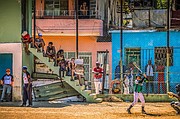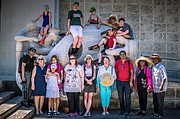One family on the trip takes a ride in a taxi cab, a classic Chevrolet convertible. Photo by Bert Schreibstein
The Edlin School, a private elementary and middle school on Sunset Hills Road in Reston, took some of its students on a spring break excursion to Cuba.
“Every spring break, Edlin School arranges a trip for the parents and kids who want to go to a foreign country, and typically we will pick one that speaks Spanish or French because we teach Spanish and French as our primary languages at the school,” said Bert Schreibstein, director of operations for the school.
The school also started teaching Chinese and Russian.
“We haven’t quite gotten to China or Russia yet,” he said.
But Schreibstein and the students who went on the trip can say they traveled where many Americans have never been before.
This was because of a long-running embargo on exports to Cuba and restrictions that were first imposed by the United States in 1960. In December 2014, former U.S. President Barack Obama and Cuban President Raúl Castro announced that the two countries would normalize relations by easing these financial, trade and travel restrictions.
A U.S.-Cuba agreement that allowed commercial flights to resume between the two countries soon followed and then Obama made a historic trip to Havana in March 2016, marking the first time a sitting president visited Cuba in decades.
ELDIN TOOK ADVANTAGE of the eased travel restrictions by visiting the country from April 8-16 under what is known as “people-to-people” travel. This travel is intended not only for tourist activities, but specifically to meet Cuban people and exchange cultural information and experiences.
The purpose of the school’s yearly spring break trips are to enlighten and expand students’ knowledge, so providing them with the opportunity to immerse themselves in the history, heritage and culture of the people who were previously inaccessible. This was a once-in-a-lifetime opportunity school administrators couldn’t pass up.
“This is a country that most Americans haven’t seen since the 1960s when the embargo went in place,” said Schreibstein.
Half of the cars that Schreibstein and his students saw were old American cars from the 1950s that made their way to the island country before U.S. restrictions were put in place.
“Some were in phenomenal condition,” he said.
The trip gave the students ample opportunity to practice their Spanish with merchants and their tour guide, but it was also eye-opening for the students.
“It’s an opportunity for cultural exposure … we really try to get the kids to see a different side of life,” said Jessica Fowler, a language arts teacher at the school. “We’ve got kids who are a little more privileged and we go and we see that not everyone has the same opportunity. We had an open dialogue about the people and a different way of looking at life.”
It was a joy for Fowler to see two cultures coming together throughout the trip.
“The kids felt really comfortable with [their Cuban tour guide],” Fowler said. “They wanted to hold his hand everywhere we went and they wanted to sit next to him on the bus. And he would talk to them about what life was like for him growing up.”
MOST OF THE STUDENTS who went on the trip play Little League Baseball so the school planned a visit to experience America’s pastime the Cuban way.
“We didn’t just go to a baseball game,” Fowler said. “We stopped and we picked up all of the Cuban kids who were playing on the team and they rode on the bus with us to the game. It was really seeing two cultures come together.”
The Edlin School’s trip to Cuba included a variety of discussions about the nation’s history, agriculture, music, religion, sports and art. Students visited the cities of Havana, Cienfuegos and Trinidad, and participated in many iconic Cuban experiences.
Other highlights of their trip included visiting Museo de Bellas Artes, Cathedral Square and Cabana Fortress; Ernest Hemingway’s former home, Finca la Vigia; learning about Afro-Cuban history, art and traditions; and taking salsa and rumba dance lessons.



